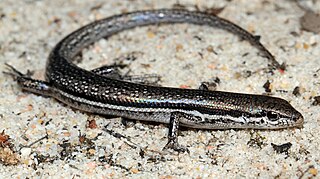
Skinks are lizards belonging to the family Scincidae, a family in the infraorder Scincomorpha. With more than 1,500 described species across 100 different taxonomic genera, the family Scincidae is one of the most diverse families of lizards. Skinks are characterized by their smaller legs in comparison to typical lizards and are found in different habitats except arctic and subarctic regions.

Panaspis is a genus of skinks, commonly called lidless skinks or snake-eyed skinks, endemic to Sub-saharan Africa.

Ablepharus budaki, commonly known as Budak's skink and Budak's snake-eyed skink, is a species of lizard in the family Scincidae. The species is endemic to the Near East.

The Annobón lidless skink is a species of lidless skinks in the family Scincidae. The species is endemic to the island of Annobón in Equatorial Guinea and is listed as critically endangered by the IUCN. The species was first described as in 1972.
Cryptoblepharus pannosus, also known commonly as the ragged snake-eyed skink, is a species of lizard in the family Scincidae. The species is endemic to Australia.
Lacertaspis chriswildi, also known commonly as Chris Wild's snake-eyed skink, Chris-Wild's snake-eyed skink, and Chris-Wild's lidless skink, is a species of lizard in the family Scincidae. The species is endemic to Cameroon.

The shrubland Morethia skink is a species of skink endemic to Australia, of the family Scincidae, found in New South Wales, South Australia, Victoria (Australia), Western Australia in Australia.
The short-headed snake-eyed skink or Peters's lidless skink is a species of lidless skinks in the family Scincidae. The species is found in western Africa.

The Cabinda snake-eyed skink or Cabinda lidless skink is a species of lidless skinks in the family Scincidae. The species is found in the Democratic Republic of the Congo and Angola.
Panaspis massaiensis, also known as the Maasai snake-eyed skink, is a species of lidless skinks in the family Scincidae. It is found in Kenya and Tanzania. Until its revalidation in 2019, it was considered of synonym of Panaspis wahlbergi.
Panaspis megalurus, also known as the blue-tailed snake-eyed skink or Nieden's dwarf skink, is a species of lidless skinks in the family Scincidae. The species is endemic to Tanzania.
Panaspis seydeli, also known as the Seydel's snake-eyed skink, is a species of lidless skink, a lizard in the family Scincidae. The species is known from the Democratic Republic of the Congo and Zambia.
The Ethiopian snake-eyed skink, also known commonly as Boulenger's dwarf skink, is a species of lidless skink, a lizard in the family Scincidae. The species is endemic to Ethiopia.
The Togo lidless skink is a species of lidless skinks in the family Scincidae. The species is found in western Africa.
Panaspis tsavoensis, also known as the Tsavo snake-eyed skink, is a species of lidless skinks in the family Scincidae. The species is found in Tsavo East and Tsavo West National Parks in Kenya; it is probably more widespread in arid lowlands further north in Kenya.

Panaspis wahlbergii, also known commonly as the Angolan snake-eyed skink, the savannah lidless skink, and Wahlberg's snake-eyed skink, is a species of lizard in the family Scincidae. The species is widely distributed in Sub-Saharan Africa. However, it likely represents more than one species.
Panaspis wilsoni, also known commonly as Wilson's dwarf skink and Wilson's snake-eyed skink, is a species of lidless skink, a lizard in the family Scincidae. The species is endemic to Sudan.
Mochlus hinkeli, also known commonly as Hinkel's red-flanked skink and Hinkel's red-sided skink, is a species of lizard in the family Scincidae. The species is native to eastern Central Africa and East Africa. There are two recognized subspecies.
Panaspis annettesabinae, also known as Sabin's snake-eyed skink, is a species of lidless skinks in the family Scincidae. It is endemic to Ethiopia. It is known from certainty only from its type locality near Bedele in the Oromia Region, southwestern Ethiopia, although there is a tentative record from central Ethiopia.
Panaspis ericae is a species of lidless skinks in the family Scincidae, native to Africa. It was first discovered in 2022 in Angola. It is named for Erica Tavares, an Angolan conservationist and biologist. P. ericae has a coppery-brown appearance and robust body.






